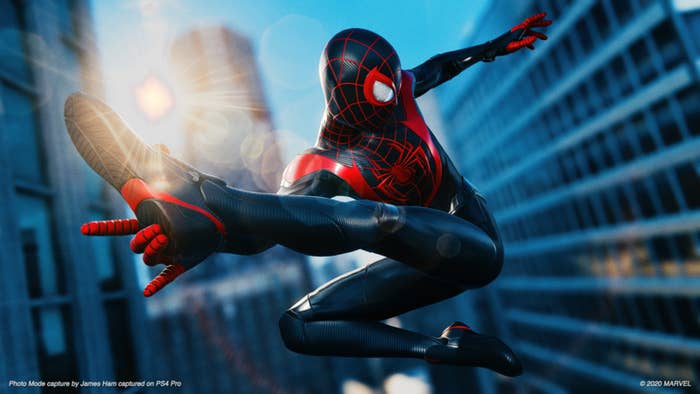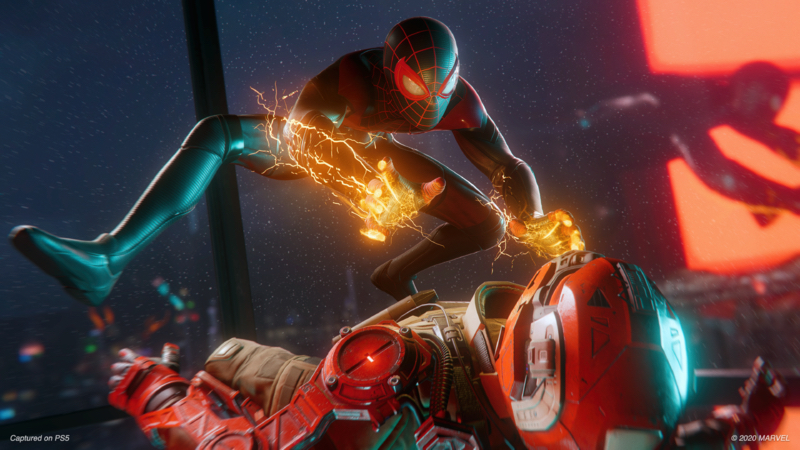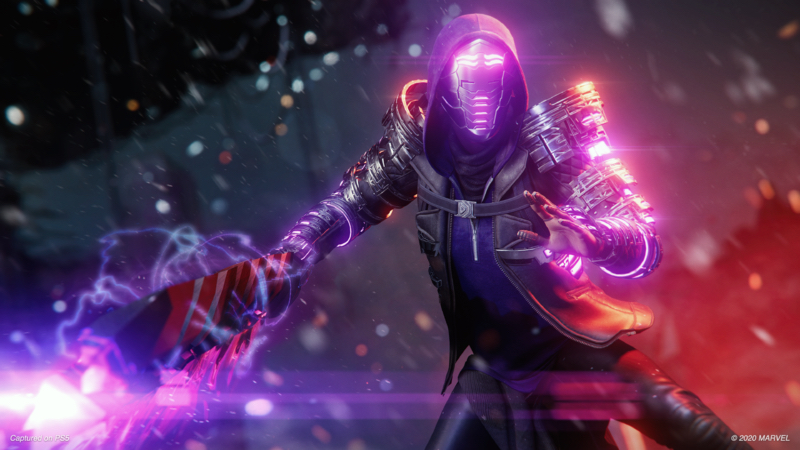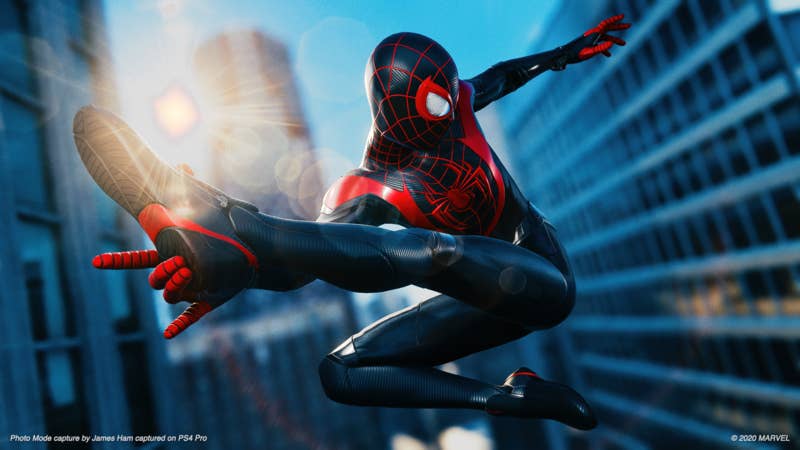
In Spider-Man: Miles Morales, you play as Miles, an Afro-Latino teenager who is clearly uncomfortable and unsettled with his new role and responsibilities. We know that, because Miles tells us; he voices his concerns out loud and reflectively, to both his family and friends. But the game's next-level brilliance lies in its use of gameplay and non-verbal visual cues to reinforce that unease.
In 2018's Marvel's Spider-Man, Peter Parker's physical movements were smooth and seamless, whether he was swinging from building-to-building or zipping from point-to-point. His stealth takedowns had a sort of professionalism to them; he had honed his tricks over the course of a crime-fighting career—a career long enough to make enemies of multiple super-villains including Vulture, Rhino, Electro, Kingpin and Scorpion. Regardless of how skilled or unskilled the player was controlling Spider-Man, the game was aesthetically forgiving. It never stopped Peter from looking slick.
Miles, on the other hand, is significantly less surefooted. Again, this is regardless of the player's skill—it's baked into the character's idle movements and gestures. When Miles perches, he wobbles the slightest bit before regaining his balance. When he web swings, his lines are not smooth; his arms and legs flail before regaining their form. When he performs a stealth takedown from high up, he exaggeratedly leans forward and then backward to compensate for the enemy's weight. One day, he'll be as smooth as his mentor. But certainly not yet.
View this video on YouTube
The web-swinging trick combos from the first game carry over into the sequel; you now have transition moves that can extend your combo for hundreds of additional points. But every so often, Miles doesn't do exactly what you want him to do; he doesn't regain his form quickly enough, or he'll fall on his face when he hits the ground. I've been experimenting to see whether it's me or him; I've concluded that this game, unlike its predecessor, emphasizes perfect input. If you want to do the perfect trick, you'll have to release your web swing at the exact right time. This game isn't going to cover for your imprecision. Again, it's an apt mirror of Miles' own struggles. He can't improvise or freestyle if he hasn't mastered the fundamentals.
A word to the wise: If you play Miles exactly the way you played Peter in the prior game, you're going to die, a lot. For context: I earned a platinum trophy on the first game, and I beat it on the hardest difficulty setting. I assumed that my elite skills from that game would carry over into this game, and make it a veritable cakewalk. But apparently, the developers had anticipated those assumptions as well.

View this video on YouTube
The first game had enemy lairs where fighting hand-to-hand was inevitable; you could stealth kill the first wave of enemies, but after that, you were permanently spotted and attacked. The new game allows you to stay hidden for the entire battle. The stealth has been accordingly fleshed out; in any room with a large group of enemies, I had a massive collection of them stuck to the ceiling or hanging from the overhead lights by the time I was done.
Plotwise, the game has lots of teen drama in it, as befitting its main character. But the game's subtext is about technocracy, and the dangers of thinking that scientific innovation is the solution to systemic problems. It makes an important point about how communities of color are usually the ones to suffer from the experimentation and implementation of those advancements, and it expresses caution about the right and wrong ways to speak truth to power.

View this video on YouTube
The cinematic set pieces, like the Rhino fight and Braithwaite Bridge sequences glimpsed in preview footage, are a definite highlight, and it's a shame there aren't more of them. Marvel has a massive rogue's gallery, and The Tinkerer, though she's given a strong backstory and character development, is no Doc Ock. Rhino is a fantastic back-up villain, but he's already been done.
I played Spider-Man: Miles Morales on a PlayStation 4, and I attained 100% completion over the course of a week. I fooled around in New Game Plus mode for a couple of days afterwards as well. I then played the PlayStation 5 version of Spider-Man: Miles Morales for about six hours earlier this week, and based on that particular experience, we're all sleeping on the DualSense controller's haptic feedback and what a game-changer that has the potential to be. "It's only a vibrating controller," you might think, but the vibrations are so oddly specific in how they correspond to the on-screen action. I appreciated that the developers showed some judicious restraint in this regard; they programmed the vibration to respond only to Miles and anything in his immediate vicinity.
To wit: If you enjoyed Marvel's Spider-Man, you're going to enjoy Spider-Man: Miles Morales, too. They are similar but not identical, and the new game adds enough that's new to carve out its own identity. Then again, familiar is nice at a time like this. It's zen, escapist, and comforting to swing around the virtual Manhattan we already explored two years ago--to know that some things don't change. Avengers Tower. The Empire State Building. The Freedom Tower. The Guggenheim. Chinatown. Harlem, lit with Christmas lights for the holidays. They're all there.
It's heartfelt, it's home, and it's something worth fighting for.




